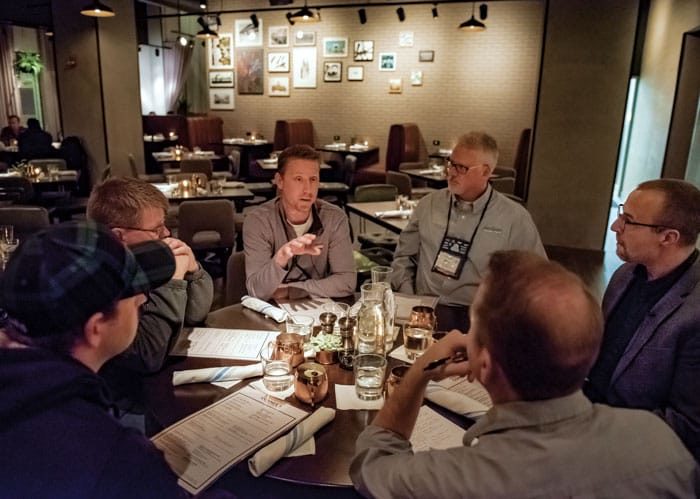Farm equipment automation is on the minds of precision dealers, whether it’s a tangible reality or far-fetched fantasy. But regardless of the take, it’s hard to ignore the impact the emerging technology will have on the ag industry.
Looking at results of the 2019 Precision Farming Dealer Benchmark study, some 42% of responding dealers cited autonomous vehicles as an area of at least moderate importance to grow revenue during the next 5 years.
During the Precision Farming Dealer Summit in Indianapolis earlier this year, we brought together 4 precision farming managers to share their insights on the opportunities and obstacles autonomy and AI could present.
At the table were Jeff Barnes, precision ag manager with Greenway Equipment in Weiner, Ark.; Shane Moore, former Integrated Solutions Manager with Pattison Ag in Swift Current, Sask.; Chad Moskal, manager, AOS with Rocky Mountain Equipment located in Western Canada; and Jason Riseley, Integrated Solutions specialist with Cervus Equipment in Alberta.
Precision Farming Dealer: Artificial intelligence is an area where we’ve seen momentum. How quickly do you think we’re going to see AI become more commercially available in ag?
Chad Moskal: “I think it’s close. We need to talk about autonomy and AI in the same breath. Until a lot of this stuff is working together, I’m not sure we can have one without the other and it be very effective.”
Shane Moore: “I agree. I think there is an opportunity for autonomy. The AI pieces, you’re going to see it coming from companies like Blue River Technology. That’s going to be the first place you see it. R&D is all well and good, but R&D doesn’t make you any money. You’ve got to sell some product to make money. I think we’ve moved at a faster pace. It won’t be another 14 years before we add automation and AI. It’s going to be pretty short now.”
Jeff Barnes: “It’s always interesting from a technology standpoint. Because you read articles about what’s happening with vehicles and electric vehicles. Someone questions whether in a few years, we’ll need charging stations instead of gas stations. You’re assuming 100% saturation of every car in the U.S. being electric. Adoption will be slow, but you still have to
support it.”

I still think the first farm to get to 90% autonomous is at least 10 years away…
— Jason Riseley, Cervus Equipment
Moore: “Producers are excited for autonomous technology. Most are excited for the simple fact if they can reduce their labor costs, they’re all over it. If it truly doesn’t decrease their labor costs, why are they changing what they know?”
Moskal: “Labor is going to be our determining factor. Unless we can automate the service trucks and the bins, we’re still going to be drastically reducing customers’ labor costs by 50%. I think our customers don’t know how well it’s going to work and taking that first step is going to be difficult.”
Jason Riseley: “Another challenge we are going to run into with autonomy is just the demographics of the land. For example, if we’ve got wet spots that change from one year to the next, how that’s going to work
with autonomy?”
Moskal: “That’s why AI is a big part of autonomy. It’s got to understand that the tractor is sinking a little, so it needs to back up. If it doesn’t have that intelligence, it’s going to roll right through and
bury itself.”
Moore: “Automation and AI boil down to efficiency because at the end of the day, efficiency is profitability. If that allows farmers to decrease their labor pool, it may not truly allow them to reduce their labor cost. Their labor cost is going to be increased in some cases because they have to hire a different level of labor. Instead of two $50,000-per year guys, they’ve got one $100,000 guy.”
PFD: When autonomy and AI fully arrive, it’s going to change the way dealers do business. It’s going to change the model. How do you see it changing your business?
Moskal: “We have to be the kings of change, adapting to it. I don’t think we’re in the positions we are, unless we’re capable, willing and looking forward. One of the things that really gets me fired up is how our group is changing and how it’s becoming more important. Within the dealership, I think we’re focusing less on the iron itself, while the technology on the iron is becoming more important.

Labor is going to be our determining factor with autonomy. We could reduce labor costs by 50% for customers...
— Chad Moskal, Rocky Mountain Equipment
“What is going to set us apart is the type of service that dealerships are beginning to support the technology within the vehicles and with the technology itself. I’m excited for that because I think we’re going to play a bigger role with every passing year on how successful the dealership is.”
Barnes: “Five years ago, we really didn’t have that much focus on internal training. I was challenged that we should be doing more training, so we embraced it. It’s a big change from where we were 4 or 5 years ago. We have our own training department for the last couple of years, and it’s possible for everything from executive training and precision guys and it works really, really well for us because we’re able to set up customized training to what our exact needs are.”
Moore: “Before I took this role, I was an operations manager for a 20,000-acre farm. For me, the excitement and passion are building efficiency into our customer’s business and whether that be through new technologies that are coming out or managing data to allow them to make decisions quicker and better. Some of the AI things that are coming, I think we’re 4 or 5 years away from. This stuff is going to hit other work ventures and our staff and customers and we’re going to have to start making decisions on how to market this and what it means.”
PFD: Imagine the day when the first person in your area has a farm that’s 90% autonomous. When is that day?
Barnes: “I would say 5 years.”
Moore: “My timetable would be longer than that. I’m going to say at least 10. In my area, we’ve got a lot of hills, bushes, oil wells, all sorts of obstacles. These autonomous companies are going to figure out how to make it work in a square field first. Let alone all these different challenges.”
Moskal: “It’s interesting to think about looking at all the customers we deal with and think about is it going to be this farmer or this farmer who takes the lead? Because someone’s going to have to. It may be some customer we hardly speak to. He’s doing his own thing, but in the back of his mind, he’s been thinking about this for years.”
Riseley: “I’ve got two customers that are using as much technology to make their operation as efficient as possible. Both customers were at their peak at the 17,000-acre mark. Their biggest challenge was the labor portion and just having enough bodies around to get the work done. They have since scaled back quite a few acres to what’s manageable for the workforce they
can attain.
“These customers will be our first to jump on the full autonomy bandwagon as soon as it comes forward. I still think that the first farm to get to 90% is at least 10 years away, but there will be certain areas of the farm that will make it to full autonomy
before that.”




![[Technology Corner] Discussing AI’s Potential Impact on Service & Support](https://www.precisionfarmingdealer.com/ext/resources/2025/04/11/Discussing-AIs-Potential-Impact-on-Service--Support.png?height=290&t=1744385717&width=400)


